AFM was granted an exclusive opportunity to interview Royal Jordanian Air Force commander Maj Gen Yousef A Al-Hnaity to discuss recent changes and the future of the air arm. Marco Dijkshoorn reports.

The Al-Quwwat al-Jawwiya al-Malakiya al-Urduniya (Royal Jordanian Air Force, RJAF) has undergone an array of projects to optimise its effectiveness since AFM’s last report on the service in February 2016. These have included modernising and standardising the aircraft inventory and overhauling training programmes and organisational structure. His Royal Highness King Abdullah II bin Al-Hussein is closely involved with the armed forces and, guided by his vision, the RJAF is quickly developing into a modern air arm in a region with no shortage of political, religious and economic pressures.
When Maj Gen Yousef became RJAF commander in 2016, the King expressed his desire to restructure, reorganise and further professionalise the air force.
“The goal of the King is to make the RJAF more efficient and effective while adhering to the budgets”, Maj Gen Yousef explained. “Based on the vision of our Royal Highness, I created a two- to three-year plan to be able to fight the threat inside and outside Jordanian borders, both working alone and working with the coalition. My three main topics for the new organisation are the right people, the right size and the right flight.”
When the commander was appointed, the RJAF operated around 29 different aircraft platforms. “You can imagine the logistical headache that comes with supporting such a number of platforms for a small air force like ours – we are not the US Air Force.” Since the major general has been in charge, several platforms have been replaced or decommissioned and air bases closed and merged in the process. New types have been introduced and the command structure changed, all with the goal of making the RJAF more efficient.
“Apart from changes in hardware and organisation, I have projects running to improve the working and living environments of NCOs and to have more female pilots in the air force.
I really want the RJAF to be an example to other air forces”, Maj Gen Yousef contended. Key changes implemented by Maj Gen Yousef include:
• Grob G 102TP replaced Slingsby Firefly T67M260 in the basic training role
• Pilatus PC-21 replaced CASA C-101CC and BAe Hawk Mk63 in the advanced and tactical training roles
• Bell UH-1H helicopters withdrawn from use
• Eurocopter EC635T1 helicopters withdrawn from use
• Eurocopter AS350B3 helicopters withdrawn from use
• Leonardo-Finmeccanica Falco UAV withdrawn from use
• Prince Hassan AB/H5 declared a Reserve Base
• King Faisal Air Base/Al Jafr declared a Reserve Base
• A Unified Helicopter Command was implemented
• Ten AS332M1 Super Puma helicopters, two CASA C295, three C-130E Hercules, 20 AH-1F Cobra helicopters and six MD530FF ‘Little Bird’ helicopters put up for sale
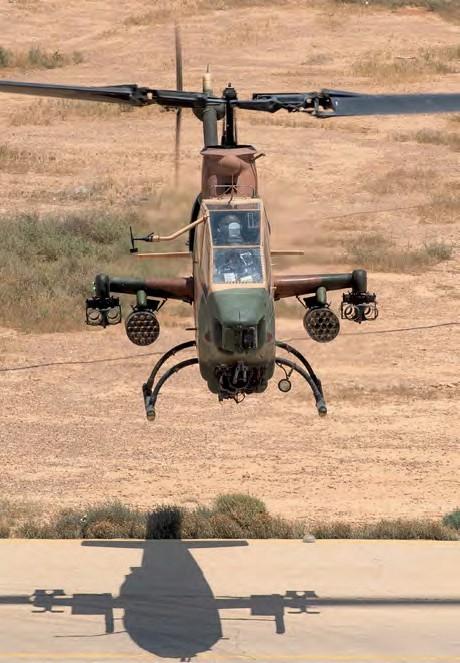
Air power update
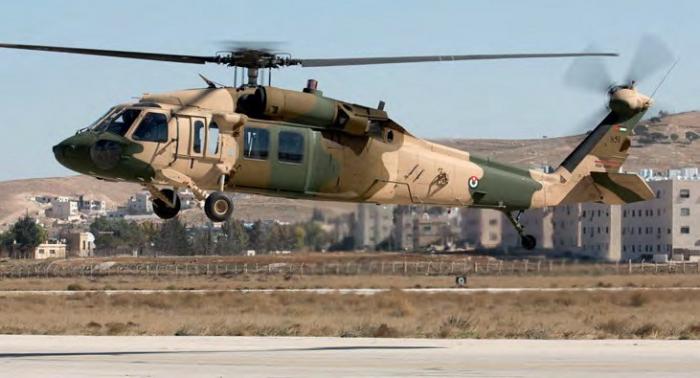
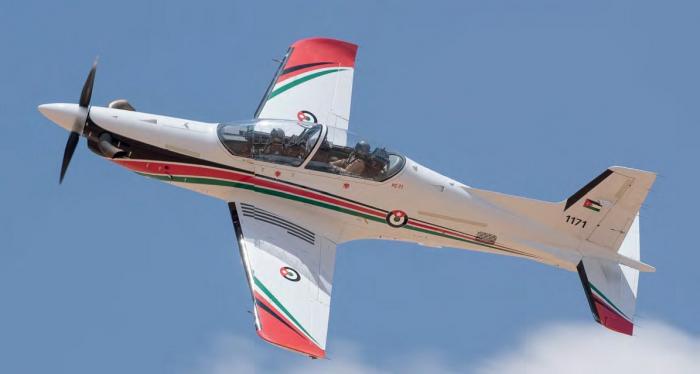
Frontline and ISR assets
In February, the RJAF received an additional batch of 15 ex-Royal Netherlands Air Force (RNLAF) F-16AM/BMs that were assigned to 2 Squadron. Before their transfer to the RJAF, the RNLAF upgraded the F-16s to the Mid-Life Update (MLU) Operational Flight Program (OFP) 6.5 standard. The aim is to keep some 45 F-16s that will all be standardised at the same OFP level and to sell the remaining aircraft. Lt Col Alyamani, wing commander at Muwaffaq Al-Salti AB, observed: “This will boost the overall mission objectives and is another major step towards the intended target of modernising the equipment.”
Meanwhile, the RJAF commander has a clear vision with regards to intelligence, surveillance and reconnaissance (ISR) assets: “We want to keep the ISR platforms that provided us the best information during the operations against Daesh [so-called Islamic State]. We have selected three platforms that we will keep in the inventory: the [Schiebel] S-100, the Cessna 208[B-ISR Caravan] and the [IOMAX AT-802] Air Tractor. With regards to the Chinese UAV, we have our FMS [Foreign Military Sales] programmes that we like very much, and the Americans would like us to adopt a US system, although this is still in the early stages.” The Prince Hussein II ISR Wing previously operated the Falco UAV, but this was recently phased out.
Special ops air assets transfer
Since July last year, the air assets of the Army Special Operations Command (SOCOM) have been transferred from the army to the RJAF. The Prince Hashim Royal Aviation Brigade (PHRB) now reports to the RJAF HQ and, with the establishment of a Quick Reaction Force (QRF), the PHRB now hosts four squadrons.
Before the transfer, the SOCOM was part of the Army General Command. Air assets and maintenance personnel were provided by the air force while special forces operators and pilots were supplied by the army. After the command change, both the aircraft and pilots are an integral part of the RJAF. The special forces pilots require a totally different skill set and experience level than their regular air force counterparts. The special operations pilots have to complete a four-to-six-month ‘Green Platoon Course’ which includes nightvision goggle (NVG) flying, low-level flying, fast roping, tactical flying and brown-out sand landings. The course is developed and executed in conjunction with the US Army 160th Special Operations Aviation Regiment (SOAR) ‘Nightstalkers’. Some advisers from this elite unit were in-country during the 2009-2010 timeframe to establish the training syllabus together with the PHRB. The US remains the closest partner for special ops training and mission execution but the PHRB trains regularly with its French, Dutch and British counterparts.
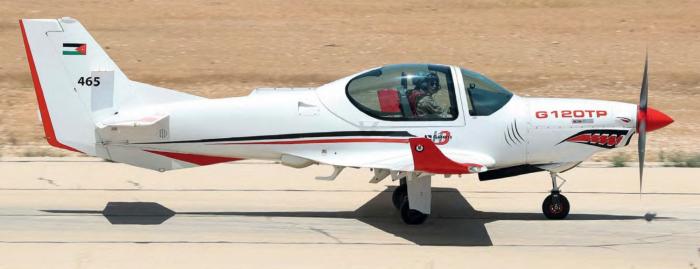
When AFM visited the RJAF back in 2015, the QRF had only just been established. The UH-60A Black Hawk helicopters then in use were operated by 8 Squadron (RJAF) out of Amman-Marka and training was provided by experienced special operations pilots of 30 Squadron (PHRB). Recently, 8 Squadron transferred to the PHRB and began flying the much more advanced UH-60M Black Hawk in the process.
Brand-new accommodation, hangars and platforms to host the unit were built, adjacent to the existing PHRB buildings. The former 8 Squadron UH-60As were transferred to 14 Squadron. A maintenance hangar and facilities were established across the runway from PHRB to accommodate the AC235 gunships operated by 32 Squadron.
Rotary revisions
Previously, helicopters were dispersed across the Air Lift Wing at Marka, the SOCOM brigade at King Abdullah II (KA2) Air Base and the attack helicopter squadrons at KA2. By forming a Unified Helicopter Command, the RJAF commander will centralise all helicopters in the Gabawi area, which encompasses Sahel Nesab (aka Zarqa AB), PHRB and KA2. Sahel Nesab until recently served as an auxiliary field for KA2 but has now been expanded and upgraded to host Mi-26T2 heavy-lift helicopters and CH-4B unmanned combat aerial vehicles (UCAVs). Besides an extended and newly paved runway, Sahel Nesab now has a new air traffic control tower, hangars and sun sheds for the Mi-26T2 and the CH-4Bs as well as offices and accommodation for troops and personnel. Construction work at the base is still very much in progress and it promises to be able to host several squadrons. Only the Royal Flight S-70A and AW139 helicopters will remain at Amman-Marka. Over the next few years, the other helicopter units will move to Gabawi to decongest the airspace over the capital.
Helicopter upgrades and rationalisation
The UH-1H and EC635T1 helicopters were recently decommissioned. The ageing AS332M1 Super Pumas are still operational with 7 Squadron at Amman-Marka but since some critical components – such as the mission computer – are becoming obsolete, the RJAF has put them up for sale.
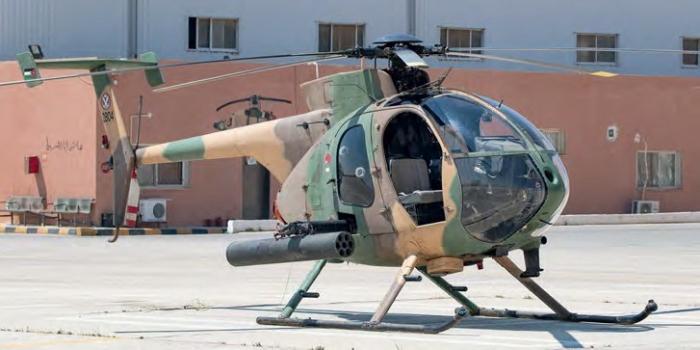

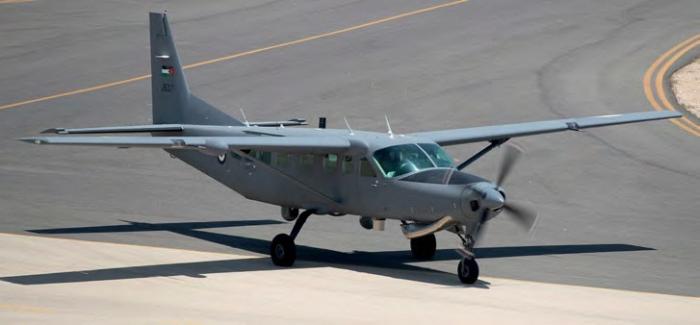
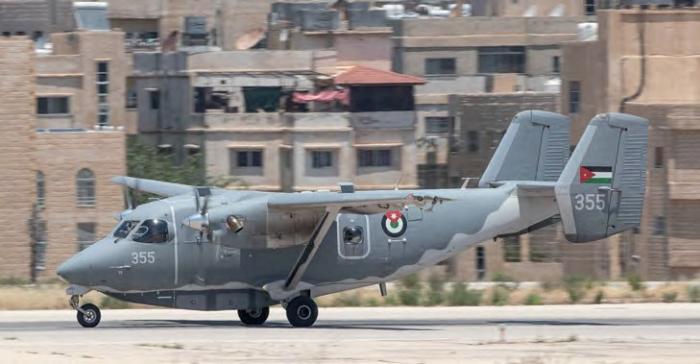
At KA2, 10 Squadron will receive the 12 AH-1F Cobras earmarked for a servicelife extension. Northrop Grumman and Science and Engineering Services (SES) are currently modernising the helicopters at Huntsville, Alabama.
Upgrades include a digital avionics conversion using Northrop Grumman’s Integrated Mission Equipment Package (iMEP), which includes a FlightPro Generation III mission computer, a full suite of LCD multifunctional displays (MFDs), an embedded software digital map and navigation controls. A new forward-looking infrared (FLIR) sensor is fitted and the upgrades add Hellfire missile capability. The SOFEX 2018 arms exhibition pushed the delivery of the first two upgraded examples forward. At the time of writing, these were awaiting operational acceptance in a hangar at KA2.
With the upgrade, it’s expected that the Cobras will soldier on for many more years. The 12 Squadron AH-1Fs will be replaced by new helicopters in due course. On the wish list are gunship versions of the UH-60, and the AH-1W. Twenty surplus AH-1F helicopters were put up for sale and two have been selected for transfer to the Philippines.
New kids on the block
Perhaps the biggest changes have been implemented within the training fleet and curriculum. In 2015, two new training platforms were selected for basic and advanced/tactical training: the Grob G 120TP and the PC-21, respectively. The initial order was for 12 G 102TPs but the RJAF soon added two additional aircraft to the order. Germany, in turn, donated another two to thank the RJAF for providing the use of al-Azraq AB to the Luftwaffe during Operation Inherent Resolve. Of the 16 aircraft that have been delivered, one was lost last December. For advanced and tactical training, the RJAF ordered ten PC-21s in early 2016. Eight aircraft have been delivered from Stans, Switzerland since August last year. Two are in their final stages of test flying and are expected in Jordan soon.
On April 17, 2016, JSC Russian Helicopters was awarded a contract to supply four Mi-26T2s to the RJAF via the King Abdullah II Design and Development Bureau (KADDB). The first Halo arrived at Amman-Marka on January 17 this year and the second is currently undergoing acceptance in Rostovon- Don. Jordan became the second foreign military customer of the Mi-26T2, after Algeria.
The training of five captains, five co-pilots, five flight engineers and four loadmasters started in Russia on June 25 last year. Eight additional loadmasters will be trained in the near future. It’s mandatory to fly the giant helicopters with a four-man crew at least. The next three helicopters are expected to be delivered to 26 Squadron/Sahel Nesab Group within the next three to six months.
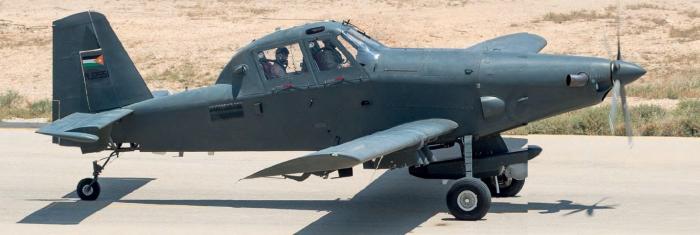
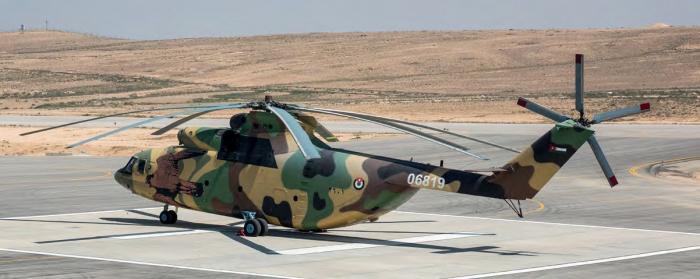
The first Mi-26T2 delivered was assigned to 7 Squadron which also operates the AS332M1 from Amman-Marka. This unit was selected as it’s a contractual obligation that before Mi-26 crews are trained, they should be certified pilots on a medium-lift helicopter. In April, the RJAF headquarters decided that the Mi-26T2 should be part of a dedicated squadron and established 26 Squadron – designated after the type.
A full capabilities study is under way to define the future roles of the Halo, which will include heavy-lift tactical transport and firefighting. A giant 15-ton Bambi Bucket is already available to extinguish fires.
This compares to the Super Puma, which instead uses a 1.5-ton Bambi Bucket. Russian instructors and support personnel are present with 26 Squadron – the warranty contract stipulates a minimum of two years’ support.
No more gladiators
Since 2015, the RJAF has been exploring new training platforms to better prepare cadets for the MLU-enhanced F-16AM/ BM. Cadets graduating from the C-101 and Hawk had to make a huge leap from fully analogue cockpits to the modern and mainly digital F-16AM/BM OFP 6.5 cockpit.
Col Ayoub Zana, commander of King Hussein Air College, told AFM: “The new training platforms are very modern, and the symbology of the instrumentation is almost like that of the F-16. In some ways, the training platforms are more advanced than the F-16s. The Fireflies assigned to 4 Squadron have been replaced by the Grob 120TP and the CASA 101CC aircraft were all withdrawn from use in May 2017 and have been replaced by the far more advanced PC-21. The training methods and syllabuses have also been adapted to accommodate the new technology. The era of the old ‘gladiators’ is over and advanced technology and new, mainly computerbased training [CBT] methods are taking over.”
With the introduction of the new types, the King Hussein Air College has fully entered the digital age. Both primary and advanced training are now supported by CBT facilities that were unthinkable with the Firefly and C-101CC. For example, the PC-21’s software enables the instructor to ‘inject’ new scenarios for the cadet, even during flight. This also applies to the simulator, where the instructor pilot will sit outside the simulator dome to evaluate the student’s performance and to intervene when necessary. In this way both instructor and cadet can adapt to every specific situation enabling far more efficient training.
The software also allows tactical training in the PC-21. Weapon systems including cannon, missiles and bombs can be simulated, making possible virtual air-to-air and air-to-ground training scenarios. After graduating from the advanced training course, cadets return to Mafraq to undergo tactical training on the PC-21. Whereas previously a separate type (the F-5E/F and later the Hawk) was needed for tactical training, it’s now standardised on one type, supported by the simulator.
Another huge advantage is that all mission systems (engine, hydraulics, weapon system, navigation, etc) are recorded and can be played back as the need arises. The level of debriefing is incredibly detailed and provides the best insight into the execution of planned mission objectives.
After the service induction of the G 102TP and PC-21, the fully analogue ex-RAF Slingsby aircraft were put into storage at Mafraq or sold to the civilian market. Seven of the venerable C-101CC jet trainers were sold to Chile as sources of spare parts for the Fuerza Aérea de Chile’s (Chilean Air Force’s) CASA fleet. Also lost in the process of rationalising were the 13 ex-UAE Hawk Mk63s. The last course to utilise these jets was the May 2017 class that completed its advanced syllabus on the CASA. The Hawks are being stored at H5 in the hope they can be handed over to an undisclosed potential buyer in the near future.
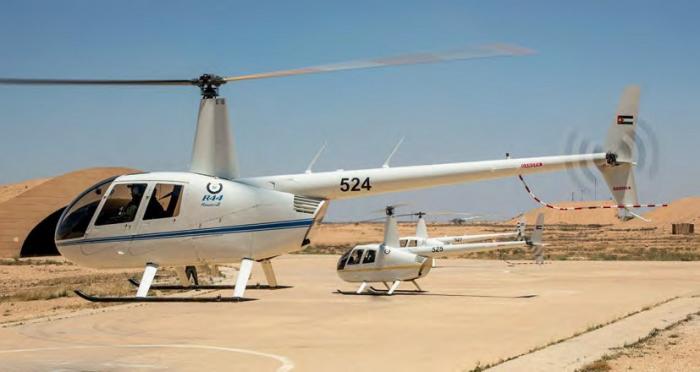
Col Ayoub continued: “One would imagine that training the cadets in only propellerdriven aircraft would result in a gap between graduation and becoming a fighter pilot. The opposite is true. The PC-21 is technologically far more advanced and capable of operating up to 8G. Therefore, the only limit is speed, but the human brain adapts to the increase in speed very quickly.”
The first class of cadets trained on the new platforms has to make the transition to the F-16. Lt Col Khawaldeh, commander of 11 Squadron said: “We are optimistic. If you look back at the CASA, the F-5 and the Hawk, you were flying something that’s not even close to the F-16, and that included the performance. The biggest problem was not the flying – most cadets did very well – but the avionics was the biggest difference. We solved that with the implementation of the PC-21.”
Students in the first class of 13 PC-21-trained cadets were due to receive their wings in July after which they will return to 11 Squadron for tactical training. During this course they will become familiarised with air-to-air and air-to-ground missions. Then they will be posted to fly the F-16 or other RJAF assets. Helicopter training has also seen changes.
Beginning in early 2016, four additional Robinson R44 Raven II piston-engined helicopters were delivered to 5 Squadron at King Hussein Air College/Mafraq. The unit now has 12 helicopters at its disposal. The AS350B3 Squirrel helicopters used by the Flight Instructor School (FIS) were sold to the civilian market in 2016 and the unit now uses 5 Squadron R44-IIs as its training platform.
Jordan is one of the coalition partners of the Saudi Arabian-led campaign in Yemen that was launched in 2015. The initial armed intervention called Operation Decisive Storm has been succeeded by Operation Restoring Hope. The RJAF participates with AC235 gunships operating out of Khamis Mushait (King Khalid Air Base) and F-16AM/BMs flying from Taif (King Fahad Air Base), both in Saudi Arabia.

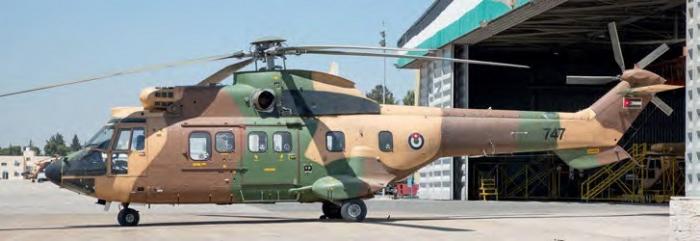
Commercialising the air force
The RJAF owns two commercial aviation companies: Jordan Aeronautical-systems Company (JAC) and Jordan International Air Cargo (JIAC). The latter currently operates two Il-76MF transports out of Amman- Marka. JAC employs mainly former RJAF personnel, ensuring that expertise and experience is not lost when maintenance personnel and officers leave the force.
JIAC executes transportation tasks on behalf of the RJAF, for both military and civil projects. Revenues from commercial assignments flow back into the RJAF. The company employs 202, most drawn from the air force. As with JAC, personnel that would otherwise retire from service are now retained, so knowledge of operating and maintaining aircraft is not lost. At the time of AFM’s visit, the two older Il-76TDs were being overhauled by Ilyushin in Russia. They were expected back in service in the third quarter of the year.
JAC provides aircraft maintenance, repair and overhaul (MRO) for civilian and military customers. The company was founded in 2000 as a civilian firm and began with civilian and military C-130 maintenance. In 2003 the RJAF took ownership of the company and it currently employs more than 200 personnel. JAC is continuously extending its certifications and aims to be Airbus A320NG certified by the end of the year. With the introduction of the CH-4B UAV, JAC set up a training facility for the RJAF and regional users such as Saudi Arabia, Pakistan, Egypt, Iraq and the UAE.
Maj Gen Yousef said: “I am very proud of what we achieved. There has been a JD1.5m [US$2.1m] investment in JAC in the first two years. Revenue in the first year were JD700,000 [US$988,000], the second year we made JD8m [US$11.3m], the third year JD10m [US$14.1m] and this year we expect to close at JD12m [US$16.9m].” Profits from JAC and the commercial transport earnings generated by JIAC directly support the Jordanian defence budgets.
Golden Eagle Aviation Academy (GEAA) also works closely with the RJAF. It flies the R44 Raven II alongside 5 Squadron at Mafraq. GEAA operates under the umbrella of the RJAF and is currently seeking foreign clients. The company uses the same syllabus as the RJAF, for both basic and advanced training.

Acknowledgements:
The author would like to thank Maj Gen Yousef and the RJAF liaison officers for their assistance in the preparation of this feature.
